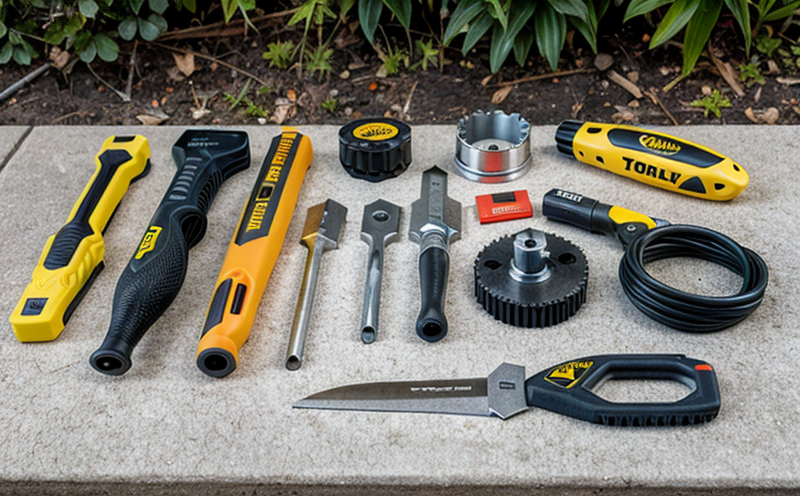Wear Resistance Testing of Hardware Surfaces
The wear resistance testing of hardware surfaces is a critical process in ensuring product durability and safety. This test evaluates how well a material resists mechanical abrasion, friction, and erosion over time. In the context of consumer products and DIY tools & hardware, this can mean the difference between a product that lasts for years and one that quickly degrades or fails.
Wear resistance testing is essential in many sectors, including automotive, construction, and consumer electronics. For instance, in DIY tools like drills, saws, and hammers, wear resistance ensures longevity and performance under heavy use conditions. In the case of hardware surfaces, this can translate to longer-lasting screws, nails, and other fasteners that are subjected to constant friction and stress.
The testing process typically involves subjecting a specimen to controlled abrasion or friction using various instruments such as pin-on-disc machines or ball-on-plate testers. The specimens are often coated with lubricants or treated with different surface finishes to observe the impact on wear resistance. After the test, the remaining thickness of the specimen is measured and compared against industry standards.
The importance of this testing cannot be overstated in industries where product longevity and safety are paramount. For example, in DIY tools like hammers and wrenches, prolonged use can lead to surface wear that affects grip, balance, or even structural integrity. In fasteners such as screws and nails, wear resistance is critical for ensuring they remain secure under varying environmental conditions.
The test parameters vary depending on the specific application of the hardware. For instance, in automotive applications, the test might focus on engine components exposed to high temperatures and pressures. In construction tools like drills, the focus would be on the bit's ability to withstand abrasive materials such as concrete or metal. The acceptance criteria are typically based on industry standards, such as ISO 10364 for screws.
By conducting wear resistance testing, manufacturers can identify potential weaknesses in their products early on, allowing them to refine designs and improve durability. This not only enhances the customer experience but also helps companies avoid costly recalls or warranty claims. For quality managers and compliance officers, this test is a valuable tool for ensuring product safety and meeting regulatory requirements.
In summary, wear resistance testing of hardware surfaces is essential in maintaining product longevity, ensuring safety, and enhancing customer satisfaction. By understanding the specific needs of each application, manufacturers can improve their products' performance and reliability, ultimately leading to increased market competitiveness.
Benefits
The benefits of wear resistance testing are manifold and extend across various sectors and applications:
- Enhanced Product Durability: By identifying weak points in hardware surfaces early on, manufacturers can enhance the durability of their products. This is particularly crucial for DIY tools and fasteners that experience high levels of friction and stress.
- Improved Safety: Ensuring that hardware surfaces do not wear down to a dangerous level helps prevent accidents and injuries. For example, screws or nails that lose grip due to wear can lead to accidents in construction or home improvement projects.
- Cost Savings: Early identification of potential issues through wear resistance testing allows companies to make necessary adjustments before mass production begins. This minimizes the risk of costly recalls and warranty claims.
- Increased Market Competitiveness: Products that meet or exceed industry standards for wear resistance are more likely to gain market acceptance. This can lead to increased sales and a better reputation in the industry.
- Regulatory Compliance: Many industries have strict regulations regarding product safety and durability. Wear resistance testing helps ensure compliance with these regulations, reducing legal risks.
In conclusion, wear resistance testing is not just about extending the life of products; it's also about ensuring they are safe to use and meet regulatory standards. This can lead to significant cost savings and increased market competitiveness for manufacturers.
Why Choose This Test
Choosing wear resistance testing for hardware surfaces offers several advantages over other types of tests:
1. Comprehensive Analysis: Unlike simpler tests, wear resistance testing provides a comprehensive analysis of how materials perform under various conditions. This includes assessing the effects of abrasion, friction, and erosion on the surface.
2. Predictive Value: The results of this test can predict future performance of hardware surfaces in real-world applications. This predictive value is invaluable for R&D engineers and quality managers who need to make informed decisions about product design and manufacturing processes.
3. Regulatory Compliance: Many industries have specific standards that hardware must meet regarding wear resistance. Testing ensures compliance with these standards, which can help avoid costly legal issues and penalties.
4. Enhanced Product Quality: By identifying potential weaknesses in the early stages of production, manufacturers can enhance product quality. This leads to more reliable products that perform better over time.
5. Customer Satisfaction: Products with superior wear resistance tend to last longer and perform better, leading to higher customer satisfaction. This is particularly important for DIY tools and fasteners where customers expect durability and reliability.
In summary, the decision to conduct wear resistance testing is a strategic choice that can lead to significant improvements in product quality, regulatory compliance, and overall market performance.





